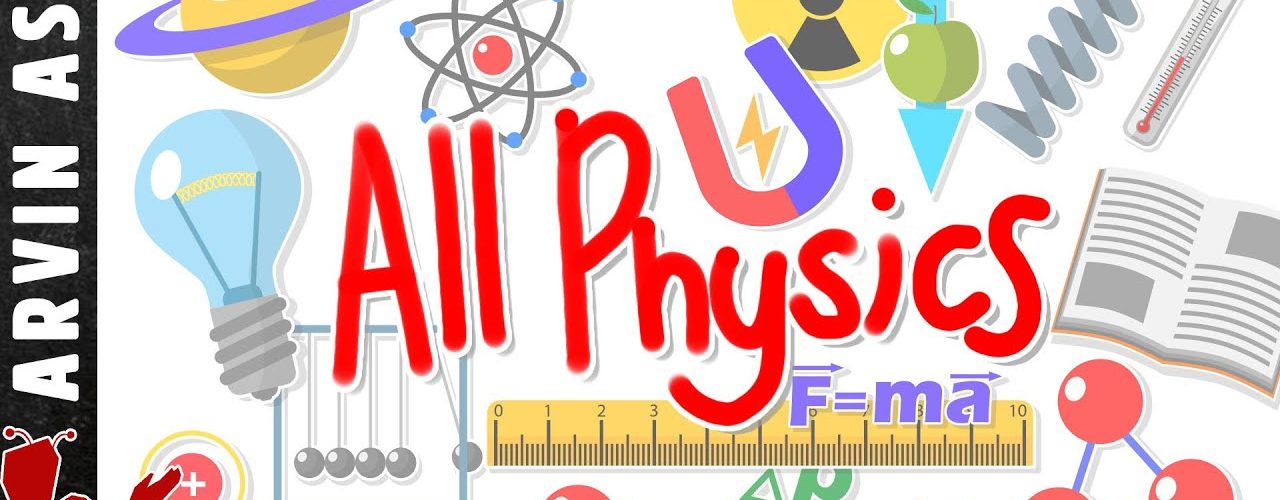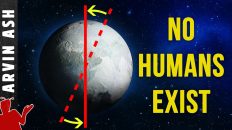All physics in 15 minutes
This video is sponsored by the great courses plus.
Even though it is impossible to teach all physics in less than 20 minutes, I recognize that the vast majority of people don’t need to understand all physics in all its complex mathematical glory.
But I do think it helps to know a little bit of physics because it is so pertinent to your daily life. Physics is at the core of reality, and is the core basis of just about all of the experimental sciences – biology, chemistry, medicine, architecture, geology, meteorology and all engineering disciplines.
So I don’t want to simply give you list of all physics. You can easily find that on Wikipedia. I am going to explain what I think are the most essential concepts, worth knowing.
Let’s face it, most people who take college or high school physics are going to forget most of it after a few years anyway, unless of course you teacher, have a technical job, or make youtube videos.
So I am going to explain only those things I think are most worthy of remembering in all of physics.
——–
There are five broad areas of physics that I think you should know a little bit about. Classical mechanics, energy and thermodynamics, electromagnetism, Relativity, and Quantum Mechanics.
Classical mechanics is probably the most pertinent to your everyday experiences. Here we have to introduce the father of classical mechanics Isaac Newton, arguably the greatest scientist of all time. There are two main concepts worthy of remembering.
The first is embodied in Newton’s second law.
F= ma
Force equals mass times acceleration. This is a deceptively simple equation that has some huge ramifications. Force in classical physics, just means a push or pull. Mass is a measure of inertia, how much something doesn’t want to change in motion. Acceleration is a how rapidly your velocity is changing.
If you apply a force to a fixed mass, it tells you how much acceleration you will get. And knowing acceleration which is the change in velocity, you can make predictions, like where an object will be at a certain time in space. So with this simple formula for example, I can predict exactly where this basketball is, and where it’s going. If I know all the forces acting on it including the friction of the air, which is also a force, I can predict exactly whether or not it will go through the hoop. This same formula can be used to determine how much reinforcement you would need to build a bridge, and how to calculate the lift of a rocket. It is an extremely powerful equation
Force is not a material thing. It is a measure of interaction. Your body doesn’t have a force. It has a mass. Your weight is the force your body exerts on the ground. Technically you don’t weigh 80 kilograms because that’s your mass. You should be saying you weigh 784 Newtons, which is your mass times acceleration of gravity on earth 9.8 m/s^2.
To give you an idea of scale, one Newton of force is equivalent to the force you would feel on your palm if you were holding a small apple.
The second equation, also from Newton, is the law of universal gravitation. it allows us to determine the motion of heavenly bodies, like the moon orbiting the earth or planets orbiting stars. It basically says that the gravitational attraction between two bodies is the product of their masses divided by the distance between them squared, times a constant, called Newton’s gravitational constant. It tells you that gravitational attraction diminishes rapidly as objects move apart because it’s proportional to the distance squared.
This was a revelation when Newton formulated it, because it explained mathematically the movement of all heavenly bodies. It still works very well today.
Energy
The ideas around Energy came about 100 years after Newton. It may be the most important idea in physics. Energy is not a vector like force or momentum, but it is just a number. Work is closely related to energy. It has the same units. Work is force times distance traveled.
One newton times one meter is one joule. If you lift a small apple one meter, that takes one Joule of energy or work. Energy is really a measure of how much work you can do. Work is simply transferring energy from one form to anther.
Energy for most objects consists of kinetic energy plus potential energy. Kinetic energy is the energy of motion. It is expressed as one half times the mass times velocity squared.
E = ½ M V^2 – the more mass you have and/or the more velocity you have, the more energy you have. Velocity makes a bigger difference in energy than mass. Going from 80 miles per hour to 60 miles per hour reduces your car’s energy by almost 50%, which means that in an accident, you have a much higher chance to survive going 20 miles per hours slower.
If you are carrying your phone and you accidentally drop it from rest onto concrete, your phone is probably going to be damaged. Where did the energy come from to damage your phone? Well, it came from the phone. The phone had what is called potential gravitational energy when you were holding it near your ear. This potential energy was converted to kinetic energy as it fell.
Gravitational potential energy is expressed as PE = m g h – mass times the gravitational acceleration times the height. This is really another way to express Force times distance. This potential energy gets converted to work or a force acting on the glass which breaks it when the phone hits the floor. So the total energy of an object is both Kinetic energy plus potential energy. Potential energy can take many forms. Gasoline or petrol for example has chemical potential energy.
The biggest thing you should remember about energy is that energy is always conserved. It is not created or destroyed. It only changes form.
Thermodynamics
Talk about energy leads naturally to thermodynamics, which is the study of work, heat, and energy on a system.
The biggest concepts worthy of remembering is flow of heat or energy. We defined energy as how much work you could do. But another form of energy is thermal energy.
If a car is moving and you apply the brakes, the kinetic energy of the car becomes zero. Where did that energy go? It did not go into gravitational potential energy. And it is not stored in the car somewhere. Did it disappear? No, it was converted to thermal energy, created by friction of the car’s brakes. Heat is a flow of thermal energy from one object to another.
Thermal energy created by the brakes raises the kinetic energy or movement of molecules in the air, this results in a temperature increase of the surrounding air. This is ultimately where the kinetic energy of your car ends up after you come to a stop.
Temperature is the average kinetic energy of atoms in a system. Thermal energy is the total amount of kinetic energy of atoms in a system.
Another concept in thermodynamics is the idea of entropy. Entropy is a measure of disorder, but more accurately it is a measure of the information required to describe the microstates of a system. The 2nd law of thermodynamics states that entropy of an isolated system can never decrease.
If you put two liquids together in a bucket. One is very cool and the other is very hot. Why can’t you get it such that the cold part gets colder and the hot part gets hotter? Energy could still be conserved because the decrease in thermal energy of the cold water, could be offset by the increase in thermal energy of the hot water. The reason this does not happen is because of the 2nd law. The universe is on an inexorable path to higher and higher entropy or more and more disorder.
Practically what this law tells us is that some energy is more useful for doing work than others. Energy at lower entropy can do more work than energy at high entropy. For example, the energy stored in gasoline is more useful for doing work, than the thermal energy that is dissipated from the brakes of your car. An orderly energy is more useful than one that is less orderly.
The heat and exhaust from the car will not spontaneously rearrange itself to become the gasoline. But gasoline can be converted to heat and exhaust. It is important to remember the words “isolated system” – If you put a glass of water in the freezer, it will decrease in entropy. But the freezer is not an isolated system because the refrigerator uses energy from electricity to cool the inside. It increases entropy of the room by heating up the room more than cooling inside the refrigerator.
You should also remember this fact: The one way flow of Entropy appears to be the only reason we have a forward flow of time.
Electromagnetism is the study of the interaction between electrically charged particles. The essential concepts are embodied in Maxwell’s equations.
Objects have something called a charge. We don’t know what it is. It is just a property of certain types of matter such as electrons. If a large object has a negative charge, this means it has more electrons than protons.
The first thing I want you to visualize is that if you have a static object with a charge, it will affect only other charges. And if you have a static magnet, it will affect only other magnets. It will not affect charges.
But if you have a moving charge, it will affect a magnet. And if you have a moving magnet, it will affect a charge.
At the simplest level of description that’s what these four equations are telling us.
The first equation says that if you have an electrical charge, there will be an electric field emanating from it.
The second equation is basically the same concept for magnets, except that magnets will always have as many field lines going out, as coming back in. Another way to say this is that magnets always have 2 poles. A positive and negative pole. It can never be a monopole. You can keep breaking up a magnet, but it will always form a new magnet with 2 poles.
The third equation says that if you move a magnet, you will create an electric field. This means that if a charge is nearby, it will feel a force. This is how electricity is generated – by moving magnets.
The 4th equation says, that a moving charge or moving electrical fields create a magnetic field.
The constants mu naught and epsilon naught are the permeability and permittivity of free space, respectively. These two constants determine the speed of light because they measure the resistance of space to changing electric and magnetic fields.
Relativity
This brings us to Albert Einstein, who ushered in a revolution in physics. Interestingly, the title of his 1905 paper on special relativity was titled, “On the electrodynamics of moving bodies.” This tells you how tied this theory is to Maxwell’s ideas. Einstein thought that if the speed of light was determined by two constants, mu naught and epsilon naught, then the speed of light is a constant too, and may not change in any frame of reference. This was one of the postulates of special relativity
The second postulate was principle of relativity, meaning the laws of physics are the same for all observes who are moving at the same velocity relative to each other. If these two assumptions were correct, this had some major implications.
Suppose you are stationary next to a train moving at 0.5C, half the speed of light, and you turn on a flashlight in the direction of the moving train. Suppose another person is on the train and turns on an identical flashlight at the exact same moment. If you saw the light beam on the train, you might think that it should be moving at 1.5 times the speed of light. But it doesn’t, it moves at exactly 1 times C. Does this mean that the man on the train sees the light beam moving at one half time sthe speed of light? No. Because of the principle of relativity, he also sees the beam of light from his flashlight travelling at exactly C. This appears to be a paradox. How can these two observations be reconciled?
What Einstein showed is that the only way this can happen is if time for the person on the train slows down from the perspective of someone standing still. This was the crucial paradigm shifting insight that he unleashed on humanity. Time was not fixed, but was relative
Later Einstein, with his theory of general relativity, showed using the same general assumptions, there would be no way to tell if you were in an accelerating reference frame or standing stationary on earth.
If you were on a spaceship moving at the same acceleration as gravity, 9.8 meters per second per second, and you held a flashlight perpendicular to the direction of acceleration, the light would appear to bend, because the wall would be rushing upwards at ever faster speeds.
This means that if you were anywhere on earth standing still, and did the same experiment, your light beam would also appear to bend because the acceleration due to gravity is 9.8 meters per second squared.
But since light always takes the shortest path between any two points, this means that space-time itself must be bending in order for light to take that path. The bent path is shortest path, just like the shortest paths on the surface of earth are bent. So space-time must curve in the presence of gravity.
Quantum Mechanics
I find it ironic that Einstein was one of the founders of quantum mechanics because he showed that light came in packets of energy, called quanta. We now call them photons. Yet, he largely stayed resistant to the main implication of quantum mechanics – and that is the idea of a probabilistic and non-deterministic nature of quantum particles.
There are many equations in quantum mechanics, but in my view there three principles that are the most important to remember. And they are expressed in three equations.
The first equation championed by Max Planck, arguably the father of quantum mechanics, says that energy is not continuous, but is quantized. The energy absorbed or emitted by materials can only occur in distinct quanta of energy. And the amount of energy equals the frequency of the radiation times a constant, called Planck’s constant. Using this concept, Einstein later showed that a photon is both a wave and a particle.
The second idea is expressed by the Heisenberg uncertainty principle. It basically says that you cannot know both a particle’s exact position and it’s exact momentum at the same time. For a particle with mass, this means that if you know exactly where a particle is, you don’t know how fast going. And if you know exactly how fast it’s going, you don’t know where the heck it is. There is an inherent uncertainly associated with quantum particles.
The third idea comes from the Schrodinger equation. It basically says that prior to measurement, quantum systems are in superposed states. This means that their properties can only be expressed in terms of a wave function. A wave function crudely simplified is a set of probabilities. So for example, in a hydrogen atom, you can’t know where to find the electron in advance.
All you can know is the probability of where you might find it, if you measured it. Prior to measurement, all quantum systems are 3 dimensional clouds or waves of probabilities. The electron is everywhere at once. It’s not here or there. It is here AND there. This is not a limitation of our measuring devices. It is a limitation of reality. And this is the reason quantum systems behave so mysteriously in the double slit experiment.
A quantum system can be an elementary particle like an electron, or even atoms and molecules that are sufficiently isolated. Isolated means that they haven’t interacted with something that would cause their wave function to collapse.
This is the non-deterministic reality that Einstein had a hard time accepting, and indeed many people today have a hard time accepting too. But the universe has no obligation to make sure we feel comfortable about the true nature of reality.
This is just one bald ape’s opinion about what he thinks are the most important concepts in physics worth remembering. I hope you found it useful.







